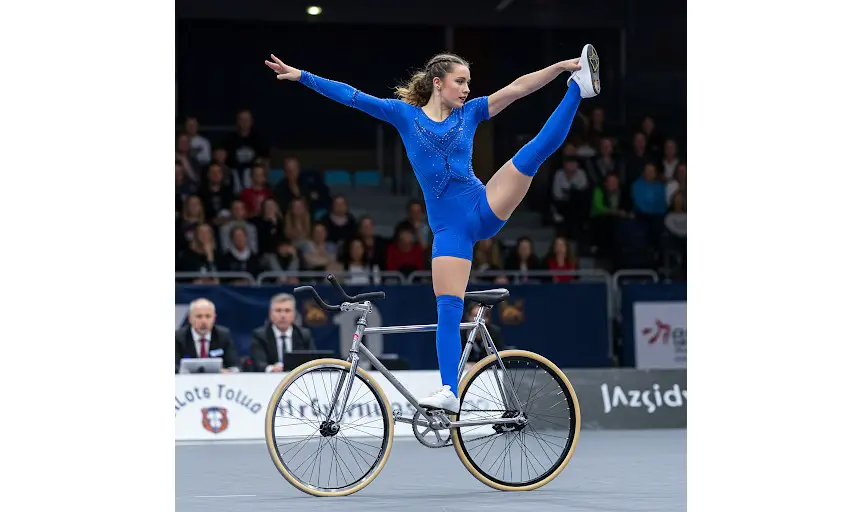
The Art of Balance: A Deep Dive into Artistic Cycling
Artistic Cycling is a sport that fuses acrobatics, cycling, and choreography into a stunning display of balance and control. It is one of the most unique and visually captivating disciplines in the world of indoor sports. Many people have never heard of it, but those who witness a performance are often left in awe. In this blog post, you will explore the origin, history, rules, popularity, and current structure of Artistic Cycling. You will also learn how it impacts society and its role at amateur and professional levels.
The Origins of Artistic Cycling
The roots of Artistic Cycling stretch back to the late 19th century. The sport began in Germany, where bicycle acrobatics emerged as a form of entertainment. Early performers demonstrated tricks and stunts on fixed-gear bikes. Their goal was to impress audiences at circuses and town fairs.
One of the first prominent figures was Nicholas Edward Kaufmann. Born in 1861 in the United States, Kaufmann became known for his cycling tricks. His performances included riding backward, balancing on the handlebars, and jumping through hoops. His shows were immensely popular and helped spread the appeal of Artistic Cycling across Europe.
By the early 1900s, the sport had evolved. It moved from the circus ring to more organized arenas. Riders started forming teams and competitions emerged. In 1956, the first official World Championships took place in Saarbrücken, Germany. This event marked a turning point, turning a niche activity into a recognized competitive sport.
The Evolution of the Sport
From humble beginnings, Artistic Cycling has grown in complexity and structure. Riders now perform in both singles and pairs categories. They execute routines on a flat surface within a basketball-court-sized area. These routines are judged based on difficulty, precision, and artistic impression.
Over time, the sport gained international recognition. The Union Cycliste Internationale (UCI), the governing body for cycling, officially governs Artistic Cycling today. New generations of athletes continue to push the boundaries, introducing more complex and elegant moves.
The design of the bikes also evolved. Riders use specialized bikes with fixed gears, no brakes, and reinforced frames. These features allow for better balance and greater control during routines.
Global Popularity and Geographic Reach
Artistic Cycling remains most popular in Europe, particularly in Germany, Austria, and Switzerland. These countries dominate international competitions and host the most clubs and training centers.
In Germany alone, thousands of athletes train regularly in Artistic Cycling. The country also runs national championships and feeder leagues for young talent. Austria and Switzerland have similar systems that support both youth and elite competitors.
Beyond Europe, the sport has gained traction in Asia. Japan, China, and Hong Kong have developed strong programs. China, in particular, has invested in training facilities and coaching. As a result, Chinese riders often appear on World Championship podiums.
Though less widespread in the Americas and Africa, small communities do exist. In the United States, a few dedicated clubs promote Artistic Cycling. Efforts continue to grow the sport through exhibitions and social media.
Despite its limited global reach, the sport enjoys passionate support where it is played. Competitions attract large crowds, especially during national and international events.
Amateur Artistic Cycling in Schools and Youth Programs
Introducing Artistic Cycling at a young age is key to its growth. In countries like Germany and Austria, children start training as early as age five. Local clubs partner with schools to offer introductory classes and training sessions.
Youth competitions serve as important stepping stones. These events help riders gain experience and confidence. Young athletes often move through age categories, starting with simple routines and progressing to advanced levels.
Coaches emphasize both physical and mental training. Children learn balance, coordination, and flexibility. They also develop discipline and concentration, which benefits their academic and personal lives.
School partnerships play a vital role. Teachers often collaborate with local clubs to integrate Artistic Cycling into physical education programs. This exposure encourages wider participation and identifies promising talent early.
In Asia, similar efforts are underway. In China, some schools offer Artistic Cycling as an extracurricular activity. This approach helps build a pipeline of future athletes.
Amateur leagues and youth tournaments are now common. These events not only nurture talent but also create community among young riders and their families.
Professional Leagues and International Structure
At the professional level, Artistic Cycling is highly competitive. The UCI Indoor Cycling World Championships is the pinnacle event. Held annually, it features the best riders from across the globe.
National teams go through rigorous selection processes. Athletes must qualify through regional and national tournaments. Only top performers earn the right to compete on the world stage.
Germany continues to lead the professional circuit. Its athletes often take home gold medals in both singles and pairs categories. China and Switzerland also perform strongly, challenging Germany’s dominance.
Professional clubs support their riders with resources and coaching. Many elite cyclists train year-round, dedicating their lives to the sport. They follow structured plans that include strength training, flexibility, and choreography.
Sponsorship remains limited, but interest is growing. Some companies have started supporting clubs and individual athletes. Increased media coverage and live streaming of events have helped build awareness.
In recent years, new leagues have emerged in Asia. These leagues aim to professionalize the sport further and provide athletes with more competitive opportunities.
Despite challenges, the professional scene continues to evolve. Passionate fans and dedicated athletes ensure the sport’s forward momentum.
Rules and Scoring in Artistic Cycling
Understanding the rules helps one appreciate the complexity of Artistic Cycling. Athletes perform routines that last up to five minutes. They must complete a series of predetermined figures, which are selected from an official list.
Each figure has a set difficulty value. Riders plan routines to maximize their score without exceeding their ability. Judges score performances based on execution, stability, and artistic expression.
A panel of judges evaluates each figure. Points are deducted for mistakes such as wobbles, touches, or incomplete tricks. Smoothness, transitions, and overall presentation also impact scores.
Riders compete in two main categories: single and pair routines. Pair routines require incredible coordination. Both athletes must mirror or complement each other’s movements with precision.
The performance area is a 14-meter square. The floor must be flat, non-slippery, and clearly marked. Riders cannot leave the designated area during their routine.
Costumes are also regulated. Athletes must wear clean, tight-fitting sportswear. Safety is paramount, so accessories that could cause injury are not allowed.
Judging is strict but fair. Every move counts, making the sport as mentally demanding as it is physical.
Social and Political Significance
Artistic Cycling, though not widely known, holds significant cultural value in certain regions. In Germany and Austria, it is a symbol of precision, discipline, and tradition. Many families pass the sport down through generations.
The sport also promotes gender equality. Both men and women compete on equal terms. Mixed pair events further emphasize collaboration and mutual respect.
On a social level, Artistic Cycling fosters community. Local clubs often become hubs for interaction and support. They bring together people from diverse backgrounds who share a common passion.
Politically, Artistic Cycling has played a role in regional identity. In areas like Bavaria and Tyrol, the sport is intertwined with local customs and festivals. It represents pride and unity.
Moreover, the sport serves as a bridge between cultures. International competitions allow athletes to connect and learn from one another. These exchanges promote peace and understanding across borders.
Governments in Europe and Asia often support the sport. Funding for youth programs, facilities, and training ensures continued development. These investments demonstrate recognition of the sport’s broader value.
The Future of Artistic Cycling
Technology will play a role in shaping the sport’s future. Tools like motion analysis and virtual training platforms offer new ways to improve performance. These innovations help both amateurs and professionals fine-tune their skills.
Increased media coverage is also key. Platforms like YouTube and Instagram allow riders to showcase their talents. These channels inspire new participants and generate interest among fans.
Efforts to include Artistic Cycling in multi-sport events are ongoing. Inclusion in the Olympics, for example, would elevate the sport’s profile. Although not yet part of the Games, advocates continue to push for its recognition.
International collaboration is essential. Countries with strong programs must support emerging nations. Sharing resources, coaching expertise, and best practices can globalize the sport.
Artistic Cycling has the potential to grow beyond its current borders. With the right support, it can inspire and captivate a global audience.
Final Thoughts
Artistic Cycling is more than a sport; it is an art form on wheels. It combines physical skill, mental focus, and creative expression. From its origins in 19th-century Europe to its current international presence, the sport has come a long way.
Whether performed by children in schools or professionals on the world stage, the dedication is the same. Athletes train tirelessly to perfect routines that last mere minutes. Yet those minutes reflect years of effort, sacrifice, and love for the sport.
Although not yet mainstream, Artistic Cycling continues to grow. Its unique blend of sport and art appeals to those seeking something different. With continued support, this captivating discipline can gain the recognition it deserves.
So next time you see a cyclist doing more than pedaling, take a closer look. You might just discover the mesmerizing world of Artistic Cycling.





